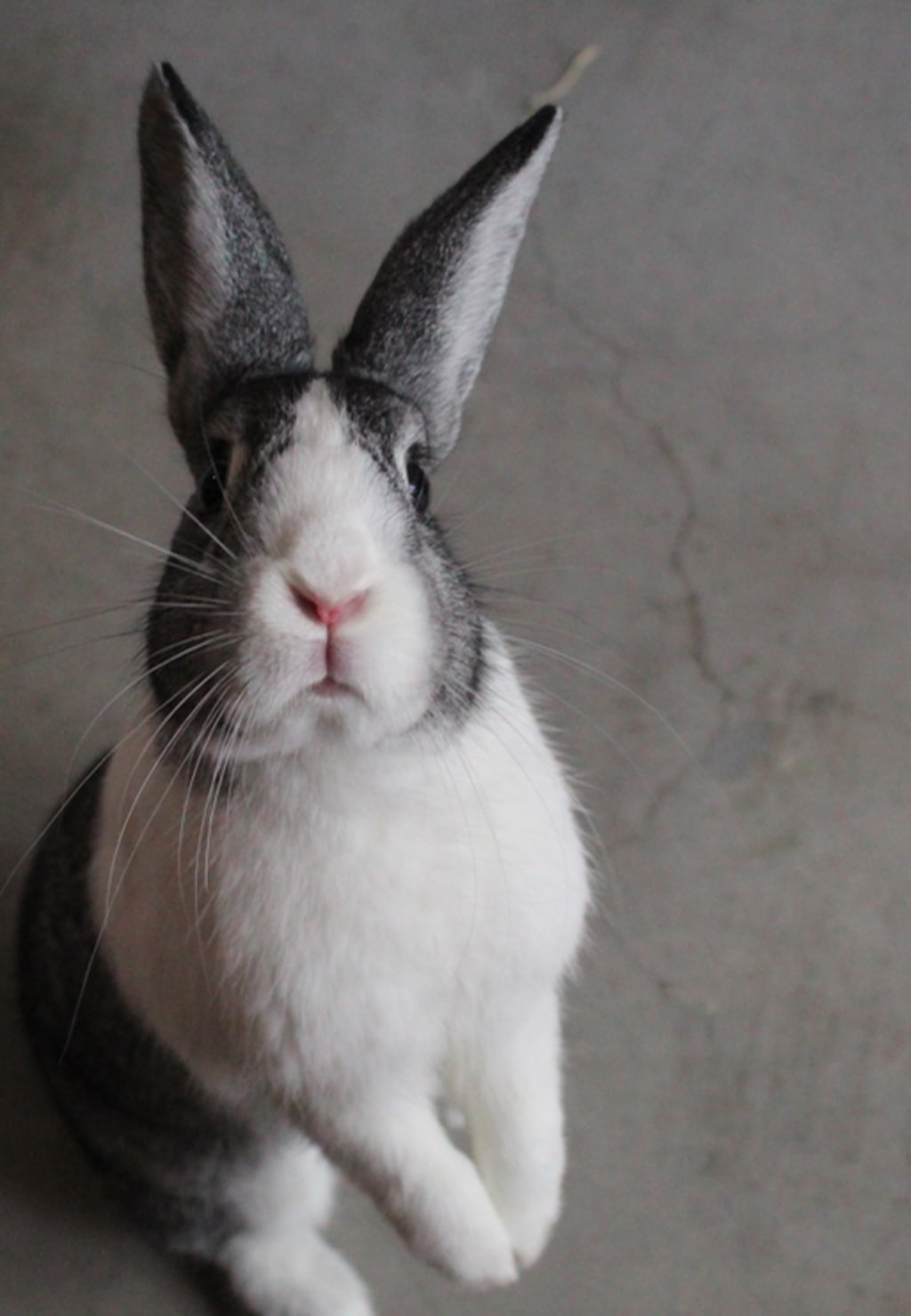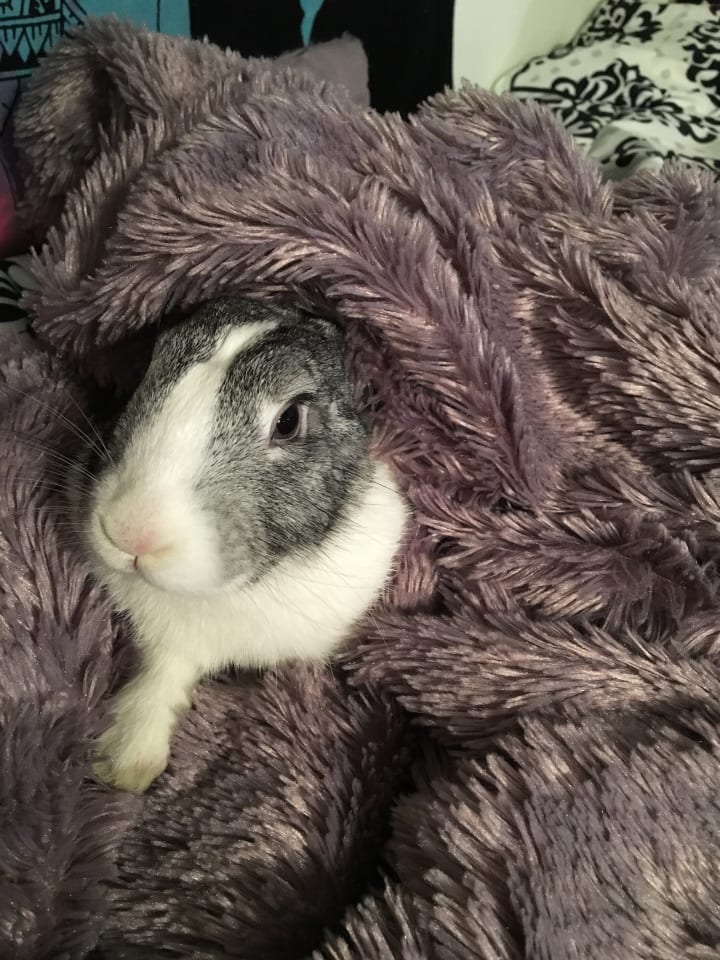The Truth About Having a Pet Rabbit
The Misconceptions, and True Education of Having a Pet Rabbit, Alongside My Story of Getting Daisy

I’ve always been one to advocate for adopt don’t shop. But sometimes, the inside of you twists your mind and heart into a knot. You see these animals behind a small glass box. Sometimes more than one in each, giving them just enough space to snuggle together to keep warm. You can't help yourself but want to take them out of that situation and give them the happiness they deserve. Other times, you walk into a pet store and your heart melts. You see these adorable fluffy, feather, or even scale-y animals that you just are dying to have to call your own, and to give a home to. Whatever the case may be, you do it. As did I. I was heading to get my eyebrows done with my boyfriend’s sister, who has also become a close friend. We arrived there way too early, stupidly not looking at what time the store opened, but saw a pet store across the street. “Oh! Let’s go in there!” I cried out, already using that voice we use when we talk to our pets. We walked in and were greeted by the friendly workers in the small shop and a bunny hoping around the store alongside a cat. Our eyes immediately drew to the bunnies and ferrets, the first two glass boxes to the left of us.
“Oh my goodness look how adorable they are!” my friend exclaimed. Quickly after this remark, we asked if we could pet them and the workers expressed that any open top glass cage was okay to touch the pets inside. Two bunnies were cuddled up and we began to pet them. One rabbit, large and soft was in the complete opposite corner laying down, fully stretched out. Another was buried under the bedding. We could barely see the bunny.
We took a look around at all the other animals, pet the ferrets, giggled at the chinchillas running on a wheel, ooo-d and awe-d at the snakes, lizards, and frogs, and whistled at the birds. Soon after our walk around the store we landed back in front of the rabbit’s cage.
“Would you like to hold one?” One of the workers asked us. Instantly I raised my hand half way up crying out my need to hold one. She asked which one, and I had pointed to the multi-colored gray and white bunny. “Three-months-old,” the worker pointed out as she explained to me how to hold her. I was scared and nervous she’d jump out of my arms and fall on the floor dead. She seemed so tiny and fragile.
“God I want her so bad,” I said, being the animal lover I am. Having two dogs at my dad’s, and two dogs and two cats at my mom’s has truly made me an animal lover. She was so cheap. My friend yelled out that she would help me pay for the supplies if I did get her. This sold me. Especially due to my usual, spontaneous spending sprees.
Short on money, I couldn’t afford a cage. I thought, eh, I’ll figure it out. It’s just a bunny. We got toys, food (pellets), bedding (shavings, which I later found out was NOT okay to use as bedding and quickly bought a new bedding), and of course, hay. Bringing back this bunny all I could do was sit in the car going, what the hell did I just do, as I held the cardboard box she sat in, most likely freaking out.
We get back to her house, also my boyfriend’s house, and see him making breakfast. “Hey! I got a bunny…” I laughed along with Leslie as I said this. He laughs and continues cooking not quite understanding. “Babe, I got a rabbit.” He walks in the living room looking concerned, laughing nervously. Leslie raises the hay and bedding.
“What the fuck!” You seriously got a bunny! You’re crazy…” He laughed and expressed his fear of rabbits due to past experiences with them. I let her out in his room as we all awe-d and waited nervously for his mom to come home to tell her as well. Which ended up going much better than expected.
Well… overtime I realized just how hard having a rabbit is. Not only that, I realized just how wrong my perception of what having a rabbit as a pet really meant. Being the animal lover that I am, I did every last bit of research I could do, not only on pet rabbits, but specifically the breed of rabbit my baby was—chinchilla Dutch rabbit. This name only derives from the fact that her fur is similar to that of a chinchilla. Through my research I realized something. There is such a misconception of pet rabbits.
The first thing you think of when you see rabbits in pet stores or hear of a person owning one is a cage. A rabbit in a cage, and a person every so often holding and caressing this cute fluffy creature. Let me break both those conceptions down real quick for all of you.
Rabbits should NOT be caged. And do NOT NEED a cage. Rabbits can be litter trained just like a cat can be, and can be a free-roamed pet just like your dogs and cats. Rabbits are prey animals, this means that they are scared about being lifted off the ground by a predator almost all the time, even when they are comfortable with an owner, some still do not like being picked up or held due to the height off the ground and the fear that it’s being prey. As an owner you must respect this if your rabbit prefers to be on the ground rather than in your arms off the ground. Some rabbits are good about being picked up, others aren’t, it really depends on your rabbit.
Daisy, was good about being held at a young age, but as she’s grown she has decided she does not like being held and I am perfectly okay with this and respect that. Instead, Daisy likes to cuddle. She sleeps with me in bed right next to my head or in between my arm and body area (the armpit area).
Also being a prey animal means hiding symptoms of pain or suffering. A pet rabbit will often hide all symptoms of an illness until it is too late. Paying attention to every detail of your rabbit’s life such as how often they pooped today versus yesterday, the way they look and the color of their urine is extremely important. Other things to look out for are how often they are drinking water, if they are lazier than usual, etc...
Litter training will not be successful until your rabbit is spayed or neutered. It is also very important to spay/neuter your rabbit due to health issues (such as cancer), most which can occur within the first few years of their life, if not fixed. Litter training can be very successful if you put in the time and effort. This requires a lot of work but usually only takes about two to three weeks at most when done properly, though each rabbit is different.
Saving up money for Daisy to get spayed was rough, especially as a college student, but I did it. I had to because she was my responsibility and it was the best thing I could do for her health and for my sanity. Spraying, and constant pooping wherever and whenever was going to continue to occur until this was done. I was washing my sheets nearly three to four times a week due to non-stop accidents on my bed.
In the beginning I wanted to give her away, sell her, or return her. I didn’t think I was up for the job or the expense. The cost of hay, and bedding adds up fast! These fade away quickly due to hay being needed 24/7, and them eating it where they poop/pee. Therefore it soaks up and fills up quite quickly. Once hitting their teenage years, around six to seven-months-old they can revert to an all veggie diet, consisting of leafy dark greens (veggie spring mix). Some not even needing pellets, though I give some to my girl every once in awhile mid-day if I am going to be late for her dinner. She’ll go through a box of veggie spring mix every week, that adds up as well.
I eventually convinced my friend who had helped me get Daisy to buy a rabbit of her own. This helped me, it made me feel like someone was struggling with me, and was going through the same thing as me, and we’d get through it together. Finally, after several weeks of working I was able to afford surgery for Daisy to get fixed. This helped everything! It also helped me see Daisy for something more. An animal I can bond with, cuddle with, and not be frustrated with for peeing and pooping on my bed, due to her learning the litter box fairly quickly.
She started off in a plastic play pen, but quickly was able to figure out how to escape by pulling at the Velcro bottom and sliding under. I soon got a metal play pen, one that was too short and she easily learned how to climb or jump out of.
Yet, after stumbling across a YouTube channel of Lennon the Rabbit, and more research, I quickly realized how Daisy could be COMPLETELY free roamed. At the time I was covering cords or areas I didn’t want her getting to with cardboard boxes from Chewy. This was fairly successful, but sometimes she could squeeze her way through. Overtime, I have advanced to bunny proofing my room with cord covers, and moving my furniture in a way in which no spaces weren’t safe for her to hop into.
Daisy has recently become my ESA (emotional support animal). Yes, you can have a rabbit as an ESA animal. Due to my severe anxiety, I was able to get Daisy certified through my therapist as my ESA, she is now able to live with me and go with me, anywhere. Many people don’t see how a rabbit could do anything for a human, but the bond you can form with your pet bunny is incredible. They are smart, know their name, learn certain words like “treat” or “turn” when learning tricks. They enjoy cuddling and being pet just like any other animal. They have the best quirky goofy, adorable characteristics such as binking, flopping, and zooming.
I have grown immensely close with my Daisy, and I hope that this story has changed your mind about what having a pet rabbit really means. The expenses, education, and dedication needed to own a bunny is important to note prior to getting one.










Comments
There are no comments for this story
Be the first to respond and start the conversation.